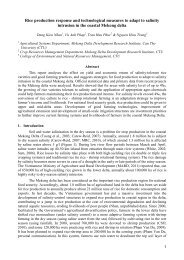start-with-the-park
Create successful ePaper yourself
Turn your PDF publications into a flip-book with our unique Google optimized e-Paper software.
Thinking about design<br />
63<br />
2. Character and<br />
distinctiveness<br />
Parks, squares and gardens form an<br />
important component of <strong>the</strong> identity of a<br />
place, reflecting <strong>the</strong> complexity of local<br />
landscape, culture and heritage. At <strong>the</strong>ir<br />
best, green spaces can become <strong>the</strong><br />
proud symbols of an area.<br />
Understanding <strong>the</strong> character and threedimensional<br />
shape of <strong>the</strong> landscape is<br />
an essential step in designing successful<br />
green spaces. Natural features such<br />
as rivers, streams, woodlands, trees,<br />
hedges, wetlands, hills and valleys should<br />
be protected and integrated into designs.<br />
These can help to deliver a range of<br />
benefits, such as providing attractive<br />
routes along river or woodland corridors,<br />
or protecting homes from prevailing<br />
winds through planted shelter belts.<br />
They also help to create a distinctive<br />
sense of place.<br />
A successful green space will usually<br />
promote and reflect <strong>the</strong> identity and<br />
culture of a local community. Involving<br />
local people in <strong>the</strong> design process will<br />
help to achieve this. Every element of <strong>the</strong><br />
green space design contributes towards<br />
its identity. The choice of planting,<br />
materials, furniture, railings, paving and<br />
public art can all be important.<br />
Public art should be integrated into <strong>the</strong><br />
design of <strong>the</strong> space at <strong>the</strong> outset ra<strong>the</strong>r<br />
than being added on at <strong>the</strong> end of <strong>the</strong><br />
design process. It should enhance<br />
people’s appreciation of <strong>the</strong> landscape<br />
and public realm.<br />
Public art on its own will not save<br />
a poorly designed space.<br />
‘Fight for au<strong>the</strong>nticity<br />
and integrity…Value <strong>the</strong><br />
common place. Our cultural<br />
landscapes are our ordinary<br />
history and everyday<br />
nature intertwined…Let <strong>the</strong><br />
character of <strong>the</strong> people and<br />
<strong>the</strong> place express itself…<br />
Don’t fossilise places.’<br />
Sue Clifford, Common Ground<br />
‘Local planning authorities<br />
should not attempt to<br />
impose architectural styles<br />
or particular tastes…it is,<br />
however, proper to seek to<br />
promote or reinforce local<br />
distinctiveness particularly<br />
where this is supported by<br />
clear plan policies<br />
or supplementary planning<br />
documents on design.’<br />
PPS1 (ODPM 2005, para. 38)





